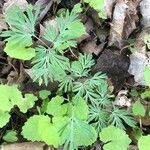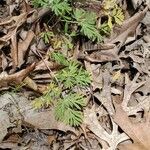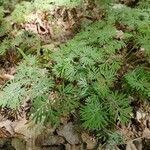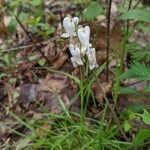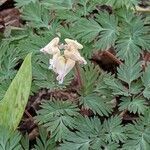Much like no. 1 [Dicentra cucullaria (L.) Bernh.]; bulblets fewer and about twice as big, pea-shaped, yellow; lvs typically 1 per scape, blue-green, glaucous; cor narrowly ovate, its spurs short, broadly rounded, scarcely divergent; nectary-spurs 0.5–1 mm; 2n=64. Rich woods; s. Me. and s. Que. to s. Minn., s. to N.C., Tenn., and Mo. Apr., May.
A plant that keeps growing from year to year. It grows 25 cm high and spreads 30 cm wide. It develops tubers. The stems are slender and arch over. The leaves are divided along the stalk into a number of lobes. The leaflets are wedge shaped. The flowers are greenish-white and have purple tinges. They are heart shaped and hang down.
